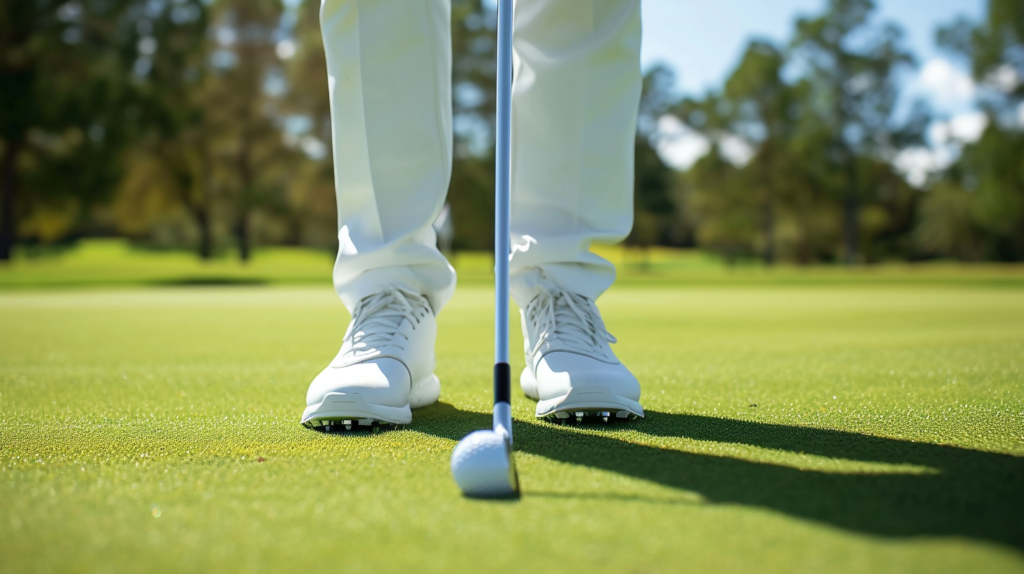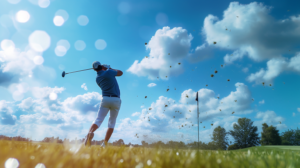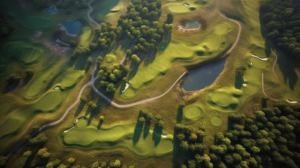Do embarrassingly topped shots make you want to toss your clubs in the lake? If chopping the turf far more often than launching drives into orbit has you fuming, this guide to curbing topped shots is an essential read.
We’ll cover proper address position, helpful grip checkpoints, ideal ball placement, level shoulder turn, effective downswing sequence and custom club fitting considerations to get your swing back on plane. Let’s dive in to unlocking your best ball-striking ever…
How to Stop Topping the Golf Ball

The key to stopping topped shots is to set up with proper posture and ball position, maintain spine angle all the way through the swing, and fully release the clubhead through impact allowing your wrists to unhinge naturally.
Play the ball off your front foot, keep your head still and swing the club down toward the back of the ball with a steeper angle through impact.
Allow your body to fully rotate clearing the way for an unrestricted release. Compress the turf just beyond the ball instead of sweeping across the top.
Check Your Stance And Posture

One of the most common causes of topped shots is an improper stance or posture at address. If your posture is too upright or your stance is too wide, it can cause you to swing too steeply into the ball.
Here are some key checkpoints for your address position:
Stand closer to the ball with your feet about shoulder-width apart. Standing too far from the ball encourages dipping and swaying rather than rotating around your body.
Place the golf ball off your left heel for most shots with irons and woods. Your stance should feel athletic as if you’re ready to jump straight up in the air.
Bend more at the hips to tilt your spine away from the target. Your spine angle should match the same angle you want on the clubshaft at impact. This athletic “ready” position preset the proper angles for an on-plane downswing.
Avoid bending too much from your waist alone as this can cause dipping and early extension.
Keep your head and eyes still throughout the entire swing. Any up-and-down head movement makes it harder to return the club to impact consistently.
Pick out an intermediate target in front of your ball to keep your gaze centered.
Grip The Club Lightly With Your Fingers

In addition to your stance, the way you grip the club can either help or hurt your chances of topping the ball. Many golfers squeeze too hard in an attempt to hit the ball farther.
This excess tension prevents the club from releasing properly through impact.
Hold the golf club mostly in your fingers rather than pressing it into your palms. Keep a light, relaxed grip to allow your wrists to naturally hinge and unhinge during the swing.
Avoid placing the handle too far into your palms at address.
Focus on keeping a light pressure in your last three fingers on both hands. This will help you square the face as you swing into the golf ball.
If you feel tension creeping up your forearms, shake your arms loose and rebuild your grip.
Avoid squeezing too tight as you swing into impact. Last-second effort causes your upper body and arms to tighten up rather than releasing through the shot.
Make practice swings feel smooth and free of tension before stepping up to hit any golf shots.
Position The Ball Correctly

Ball position plays a major role in preventing topped shots, yet it’s one of the most overlooked aspects of ball-striking. Simply placing the ball too far forward or back in your stance can ruin your ability to compress properly.
Here are some ball position pointers:
Play the golf ball off your front foot, in line with the instep of your left shoe if you’re a righty. This inside placement encourages compressing into the back of the ball rather than sweeping across the equator.
Keeping the ball up encourages a downward strike rather than a level or upward strike.
Make sure your ball position is consistent from shot to shot based on the club you have selected. A centered ball works well for short irons while long irons and woods call for playing the ball toward your front heel.
Hybrids and fairway metals fall somewhere in between short and long shots.
At address, you should have about 60% of your weight distributed onto your front foot which helps you maintain your spine angle all the way into impact. Keeping your weight back predisposes scooping and thinning the shot.
Make A Level Shoulder Turn

The shoulder turn is one of the most important — yet often overlooked — parts of the golf swing when it comes to ball striking. Dipping your lead shoulder too low or lifting your trail shoulder too high on the backswing are common mistakes causing topped golf shots.
Don’t allow your lead shoulder to dip too low on the backswing causing your swing plane to become too steep. Keep both shoulders turning evenly on the same plane angle around your spine.
Imagine your shoulders and hips turn together around the axis of your spine.
Keep your swing motions smooth and seamless focusing on one-piece takeaway rather than breaking the club up with your wrists too early. Starting the club back low and slow prevents it from getting too vertical in the backswing.
Making a full, level shoulder turn loads your leg muscles properly for generating power. It also keeps the club moving on the proper plane angle through the hitting zone. Any dipping, swaying or sliding prevents solid contact.
Swing Down And Through The Ball

Now that your setup and backswing are dialed in, it’s time to focus on the downswing and strike. Compressing the golf ball requires swinging from high to low with plenty of speed rather than sweeping across the ball.
Initiate the downswing with your lower body, driving your legs and core muscles toward the target rather than just dropping your arms. Your downswing sequence should feel like lower, upper then arms in one smooth motion.
Swing the club down toward the back of the golf ball with a slightly steeper angle than you would with irons. Sweeping too level is one of the most frequent causes of topped woods and hybrid shots.
You may feel like chopping down rather than sweeping along at impact.
Allow your wrists to fully release just after impact, slinging the clubhead through toward your target. Full release generates maximum clubhead speed for distance and compression.
Follow all the way through toward your intermediate target.
Compress the golf ball solidly by keeping the club low, taking a divot after impact. Well-struck shots sweep the turf just beyond the golf ball sending the ball soaring on your intended initial line.
Topped shots barely get airborne and have no flight pattern consistency.
Get Custom-Fit Clubs

One last check if you continue fighting your driver or long irons is getting custom fit for clubs built specifically for your swing type. Standard clubs come in standard lengths that may be too short for your build and posture, making it harder to find the sweet spot consistently.
Extending shaft lengths up to an inch or two longer can help you naturally swing the club on an ideal plane, preventing steep, choppy strikes altogether. Custom fittings don’t have to break the bank and can cure chronic topping frustration.
During your custom golf club fitting, a launch monitor measures key impact and performance metrics while you test hit each club option. Factors like lie angle, shaft flex rating, grip style and diameter can be matched precisely to your swing path and speed for ideal ball striking.
There you have it — a comprehensive guide to squashing topped shots based on proper setup, backswing, downswing, impact and equipment customization. Pay attention to these areas during range sessions.
Once the muscle memory locks in, you’ll stop worrying about embarrassing topped mishits.
Conclusion
Topping the ball can be incredibly frustrating, but with some adjustments to your setup, grip, swing path and equipment, it can be cured. Focus on consistent ball position, maintaining spine angle and releasing through the shot.
If you continue to struggle even after implementing these tips, visit your local pro for a custom club fitting. With the right tools and techniques now in your arsenal, you’ll be compressing crisp iron shots and bombing drives in no time.
What parts of your game will you work on first to stop topping the ball?



